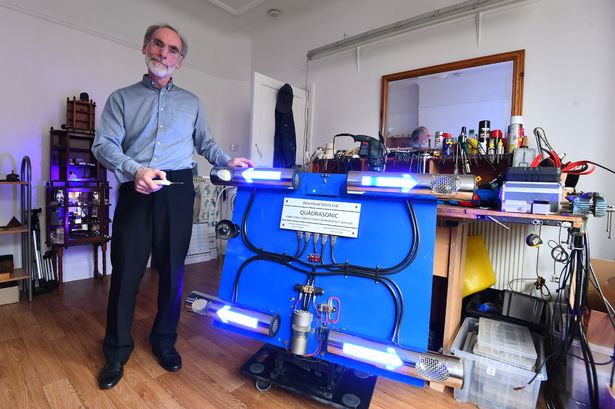An inventor who is fascinated by sound believes his latest creation could help save lives.
Jez Brandon, a 70 year-old scientist from Mossley Hill , has previously created a remote controlled sound beacon to help blind people navigate their way around. Jez has also made stereo headphones which enabled blind people to play archery, with beeps telling them where to fire depending on the pitch of the beep and which ear the beep is being played in.
But for the last ten years his attention has been on a sound which has bugged him throughout his life – emergency sirens.
READ MORE: Mum attacked Ryanair steward after she was asked to stop vaping
Born and bred around the Penny Lane area, Jez said: “I can remember we used to have a fire station and a police station just down the road. I could tell from my bedroom exactly where they were going when they used the old fashioned bells.”
When he was a young adult however, Jez noticed the introduction of “yelp and wail sirens”. He said: “I was listening to these new sirens, the yelp and the wail – I call them screechers. I thought, these just don’t seem to work.
“You might have yourself experienced hearing an emergency vehicle and not heard where it’s coming from. I was quite moved to develop this system.”
Describing how the sound of the siren travels, Jez, who runs a company called Directional Sirens, said: “It will bounce off a surface, bounce off another surface and come back at you from a completely different position without sounding any different to the original sound. You don't know whether it’s close, where it’s coming from.”
He added: “The consequences are very, very severe. This is why people will drive in front of a fire engine or ambulance, even though it's an open space and there’s no obstructions. It causes psycho-acoustic trauma – because the noise is so piercing, people freeze, or they panic. And that's where, sadly, the accidents occur.”
According to Directional Sirens website, there are around 25,115 serious injuries and 2,730 fatalities every five years involving emergency service vehicles and members of the public in the UK, USA and Canada.
According to Jez, his Directional Quadrasonic Sirens use the doppler effect, which is key to working out whether something is coming towards you or away from you acoustically. Describing a time he demonstrated the siren with Merseyside Fire and Rescue Service, he said: “They had a fire engine in front and my system on a fire engine following behind. We went through urban and open space situations.
“[The firefighter] said, ‘I could hear you well before I could see you.’” From this, Jez argues that it will be quicker for people to work out where the siren is coming from.
This will quicken the speed at which other drivers get out of the way of emergency vehicles, reducing road collisions and allowing police, ambulances and fire trucks to get to the scene of an incident faster. After years of testing, Jez has manufacturers who are interested in making more of the sirens, who will then sell them onto the emergency services.
The scientist has been left surprised by how few regulations there are around what sirens can and can’t sound like. He firmly believes that the sirens could save lives across the world.
He said: “This would set the standard worldwide. It's universal, it would apply to every emergency vehicle.”
Jez is passionately against the use of different sirens for each emergency service, which can cause further confusion to those nearby. He said: “You’ve only got seconds to get this sorted out in your brain, so a universal siren means you don't have to think, you just react – calmly.”
Win £200 Aldi shopping voucher to help with your summertime spending
Don't miss the biggest and breaking stories by signing up to the Echo Daily newsletter here
Discover, learn, grow. We are Curiously. Follow us on TikTok, Instagram, Facebook and Twitter.

